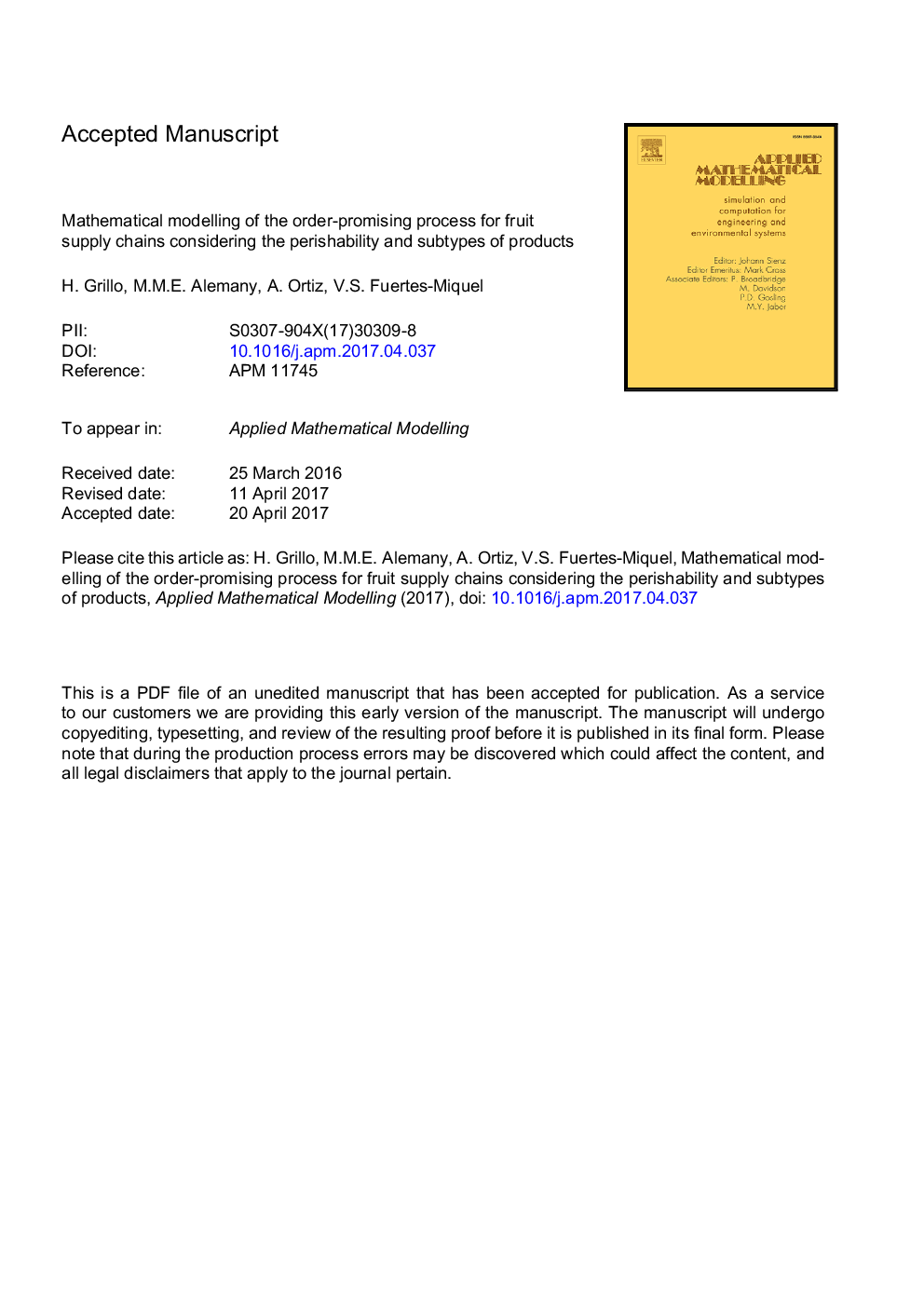| کد مقاله | کد نشریه | سال انتشار | مقاله انگلیسی | نسخه تمام متن |
|---|---|---|---|---|
| 5471093 | 1519384 | 2017 | 45 صفحه PDF | دانلود رایگان |
عنوان انگلیسی مقاله ISI
Mathematical modelling of the order-promising process for fruit supply chains considering the perishability and subtypes of products
ترجمه فارسی عنوان
مدل سازی ریاضی فرآیند امیدوار کننده سفارش برای زنجیره تامین میوه با در نظر گرفتن فاسد شدن و زیرتیمین محصولات
دانلود مقاله + سفارش ترجمه
دانلود مقاله ISI انگلیسی
رایگان برای ایرانیان
کلمات کلیدی
فرایند امیدوار کننده در دسترس بودن به وعده، عدم همگن بودن در محصول، زنجیره تامین میوه، فاسد شدن
ترجمه چکیده
این مقاله یک مدل برنامه ریزی ریاضی عدد صحیح ترکیبی را برای پشتیبانی از فرایند پیچیده نظم و انضباط در زنجیره تامین میوه ارائه می دهد. با توجه به عوامل طبیعی مانند زمین، هوا و یا زمان برداشت، این زنجیره های عرضه واحد هایی از یک محصول مشابه را در اختیار مشتریان (زیرموها) قرار می دهند. این مشکل مدیریتی می شود زمانی که مشتریان در سفارشات خود به نوع خاصی نیاز دارند. علاوه بر این، از بین رفتن ویژگی های اصلی زیراته ها با گذشت زمان باعث ایجاد زباله می شود و سیاست قیمت گذاری مبتنی بر سرقفلی را ایجاد می کند. بنابراین، مدل توسعه یافته باید اطمینان حاصل شود که مشتریان نه تنها مقادیر و تاریخ، بلکه همگن بودن و طراوت مورد نیاز را نیز تامین می کنند. هدف این مدل، حداکثر رساندن دو هدف متضاد است: سود کلی و متوسط طراوت محصول. نوآوری این مدل از نظر هر دو همگن بودن در زیراته ها به عنوان یک الزام در سفارشات مشتری و ردیابی خرابی محصول در طول زمان است. سناریوهای مختلف با توجه به وزن اختصاص داده شده به هر هدف، طول عمر طول و سیاست قیمت گذاری در یک طرح افق تعیین می شود. آزمایش های عددی برای یک زنجیره تامین نارنجی واقعی و نارنجی انجام شده و روایی مدل و رفتار متضاد دو هدف را نشان می دهد. بالاترین سود در هزینه پایین ترین درجه تازه ای که تحویل داده شده است، بوسیله باریک تر شدن قیمت با طراوت تقویت می شود. در نهایت، تأثیر مثبت طول عمر محصول در هر دو هدف افزایش می یابد.
موضوعات مرتبط
مهندسی و علوم پایه
سایر رشته های مهندسی
مکانیک محاسباتی
چکیده انگلیسی
This paper proposes a mixed integer mathematical programming model to support the complex order promising process in fruit supply chains. Due to natural factors, such as land, weather or harvesting time, these supply chains present units of the same product that differ in certain relevant attributes to customers (subtypes). This becomes a managerial problem when customers require specific subtypes in their orders. Additionally, the deterioration of the original characteristics of subtypes over time generates waste and gives rise to a shelf life-based pricing policy. Therefore, the developed model should ensure that customers are served not only the quantities and dates, but also the required homogeneity and freshness. The model aims to maximise two conflicting objectives: total profit and mean product freshness. The novelty of the model derives from considering both homogeneity in subtypes as a requirement in customer orders and the traceability of product deterioration over time. Different scenarios are defined according to the weight assigned to each objective, shelf-life length and pricing policy in a rolling horizon scheme. The numerical experiments conducted for a real orange and tangerine supply chain, show the model's validity and the conflicting behaviour of the two objectives. The highest profit is made at the expense of the lowest mean freshness delivered, which is reinforced by the narrower the price variation with freshness. Finally, the positive impact of prolonging the product's shelf life on both objectives is shown.
ناشر
Database: Elsevier - ScienceDirect (ساینس دایرکت)
Journal: Applied Mathematical Modelling - Volume 49, September 2017, Pages 255-278
Journal: Applied Mathematical Modelling - Volume 49, September 2017, Pages 255-278
نویسندگان
H. Grillo, M.M.E. Alemany, A. Ortiz, V.S. Fuertes-Miquel,
